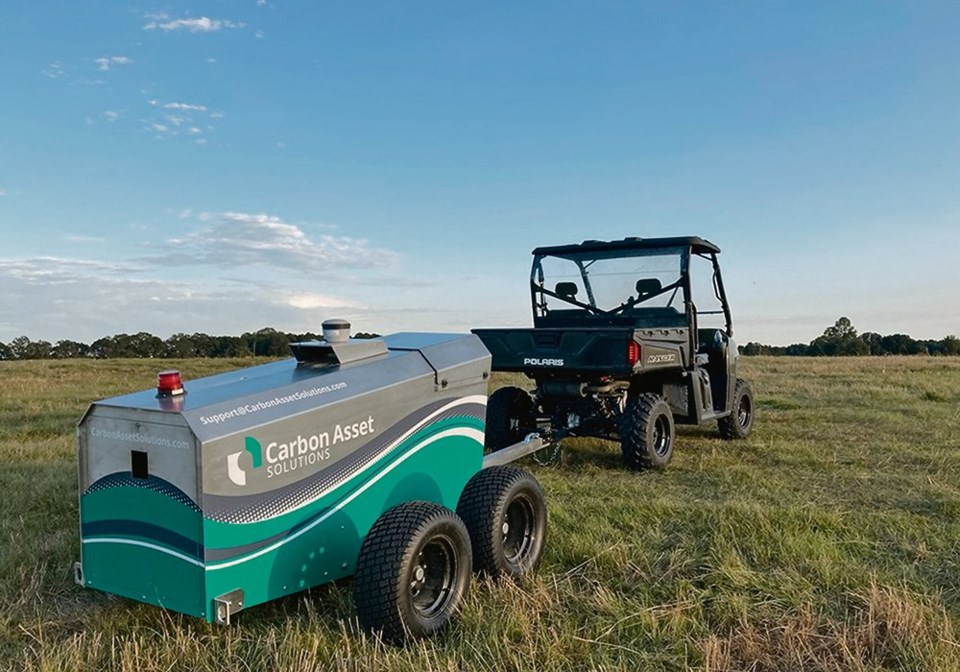OLDS, Alta. — Carbon Asset Solutions measures and records soil carbon levels in farmland, and then places verified carbon credits on an open market on behalf of farmers.
“We’re a measurement, recording, verification platform,” said Jason Bradley of Carbon Asset Solutions.
“We measure soil carbon at the atomic level, so highly precise, highly accurate and at a high volume. We work with the farmer and rancher to make changes in their practice and farming operations to increase carbon sequestration.”
Carbon Asset Solutions is an Australian company with subsidiaries in the United States and United Kingdom. Its Canadian headquarters is located at the Olds College Smart Farm in Olds, Alta.
The program begins with a baseline measurement of soil organic carbon, and then farmers commit to regenerative agriculture-based production practices that promise carbon sequestration by signing a 20-year contract.
In the first two years of the contract, before any carbon sequestration has been verified, Carbon Asset Solutions will pay farmers because of the carbon that is likely 小蓝视频 sequestered.
After two years, a second soil organic carbon measurement is taken and farmers begin to be paid in accordance with the carbon that has been sequestered in their soils, through the sale of credits sold on global carbon markets.
“It’s a 20-year contract, but we create these two-year returning payment terms within that. We forward sell the carbon credit based on what we expect or what we calculate that the farmer or rancher to sequester, based on significant research, based on personal experience and based on how we’ve seen other producers sequester at that rate.”
He said returns to farmers vary, depending on the state of their soils, their production practices, and the spot price for carbon in global markers.
Anywhere from $15 an acre up to $40 an acre and more, but that’s completely dependent upon where the carbon market goes and how well they sequester carbon,” Bradley said.
He said the contract Carbon Asset Solutions offers farmers is similar to a mortgage because it’s a longer-term financial relationship.
If producers are unable to sequester carbon in their soils due to conditions outside their control, such as drought, a contingency fund may be used to cover the carbon sequestration shortfall.
“We’ve built it into our business model by taking some of the revenue from the carbon credit sales, and we use that contingency fund as a risk mitigation tool,” Bradley said.
“We’ll have that available to cover situations where a farmer or rancher just isn’t able to sequester carbon at the rate that they had expected to, then we can cover those commitments that we made to the buyers of the carbon credit through that risk mitigation fund.”
However, if a producer decides to break the contract it could cost them.
“The exit is possible with a final settlement. Let’s say in that two-year period, we’d have to come to the end of that. But then there would be a risk offset amount that’s retained,” Bradley said.
“It’s the same as with your mortgage. If you sell your house and you’re wanting to get out of your mortgage, there’s a penalty that you pay for that at the bank.”
He said Carbon Asset Solutions does not tell customers how they must farm. The farmers decide which practices to use to help sequester carbon in their soil.
“We do understand that things change, you know weather conditions change, the market changes, or the land could be sold for instance. So, we still expect that the producer will commit and stay with those changes of practice they’ve made,” Bradley said.
“If there’s a situation where they have to do something (till when they’re committed to no-till, for example), then we can work with them to make sure that that’s just a one-off. But they still have to commit to following those changes of practice that they said they’re going to do.”
He said the technology the company uses to measure soil carbon was developed by the U.S. Department of Agriculture through their national Soil Dynamics Lab at the University of Auburn in Texas.
“They have the patent and then we have a global licence of that patent for the life of the patent. The technology itself is called mobile inelastic neutron scattering (INS).”
“INS technology is completely different from conventional soil carbon testing, the standard that we all refer to as dry combustion testing for soil organic carbon. We don’t have to do any ground truthing because we’re creating an entirely new standard with the INS technology.”
Both soil organic carbon and soil inorganic carbon are measured with the soil scanner that’s built into a trailer.
Software is used to divide fields into 20 equal size polygons, and operators of the system pull the trailer for 15 minutes within each of the polygons.
“We measure at 30 centimetres deep at one and a half metres wide. We essentially measure every carbon atom in that three-dimensional space. We move across the land between five to eight kilometres an hour and every 15 seconds we take a scan,” Bradley said.
“We’re essentially measuring more than 50 billion times more soil carbon than any of the conventional measurement standards.”
Once producers complete the initial scan, they receive a carbon map of their field, which is similar to a yield map.
“We also do a bulk density measurement of the soil within the centre of each one of those polygons. And so, when we get the percentage of soil carbon on a per-acre basis, we multiply that by the bulk density measurement that we’ve taken and then that gives us the actual tons of soil carbon per acre,” Bradley said.
Bradley said the ability to closely monitor how practices affect soil carbon will help farmers improve their soils, reduce inputs and improve profitability beyond the income achieved through selling carbon credits.
Carbon Asset Solutions was founded in 2018, its last funding round was a Series A that raised $1 million on October 1, 2020.




